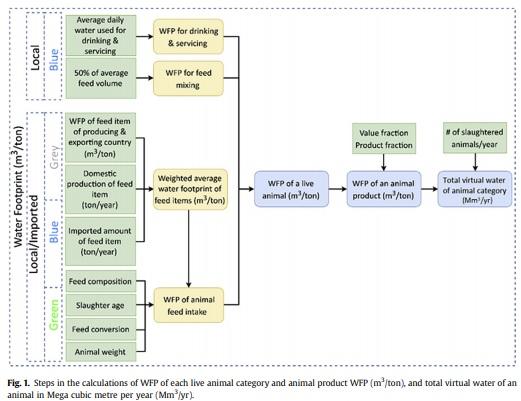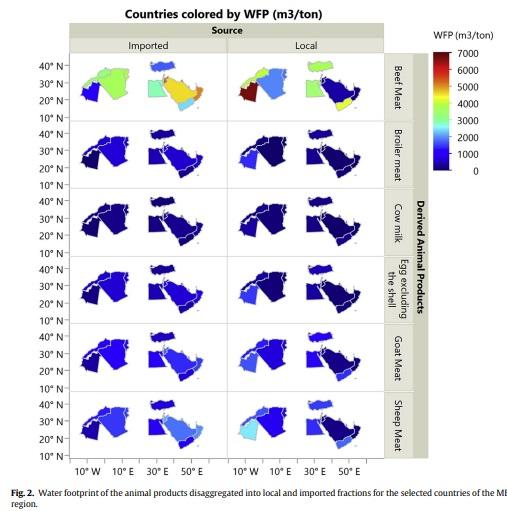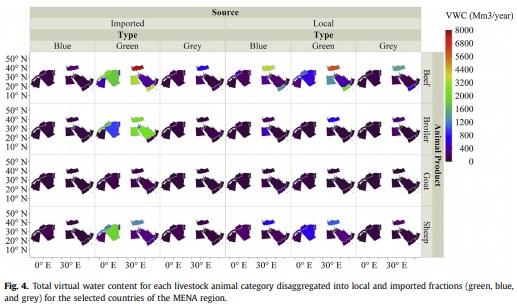Dataset used for assessing animal and poultry production water footprint in selected countries of the MENA region
This article describes the data used to assess and quantify the local and imported (green, blue, and grey) fractions of unit and total water footprint of six categories of livestock animals along with their derived products in 14 selected countries of the MENA region. Interpretation of this data can be found in a research article titled “New estimates of water footprint for animal products in fifteen countries of the Middle East and North Africa (2010e2016)” [1]. These countries are Algeria, Egypt, Israel, Jordan, Kuwait, Lebanon, Mauritania, Morocco, Oman, Qatar, Saudi Arabia, Tunisia, Turkey, and Yemen. The main farm animals covered are beef cattle, dairy cows, sheep and goats, broilers, and layers. These data cover the period 2010-2016. The data show that the MENA region consumes more than 80 billion m3 of water every year for animal consumption, most of which is imported. The proportion of imported blue water to total imported water is higher than that of the local.
Key words: Poultry, sheep and goats, beef, dairy, bluewater, green water.



For the imported fraction, we multiply the imported amount of the feed item by its corresponding water footprint in the exporting country. The result of this multiplication was summed and then divided over the total (imports and production).

The average feed volume (AFV) of each feed ingredient was calculated for each animal in Lebanon. AFV was multiplied by the local WFP’ (green, blue, and grey). The result of this multiplication (represented as TWFP Local in Table A4) was then summed to get the total local water for feed per year.
AFV was multiplied by the Imported WFP’ (green, blue, grey). The result of this multiplication (represented as TWFP imported in Table A4 was then summed to get the total imported water for feed per year.
In order to obtain the water footprint of feed intake per animal (WFPFT), we multiply the total water for feed obtained from Table A4 by the slaughter age of each animal.
To get the total drinking (WFP drink) and servicing (WFP service) demand for each animal (m3 /animal), we multiply the amount of water used for drinking and servicing in a year by the slaughter age of each animal.
To get the WFP for the total feed mixing (WFPMT) (m3 /animal), we multiply 50% of average feed volume by the slaughter age of each animal.
The above results on WFPFT were disaggregated into local & imported (green, blue, and grey) and that of WFPdrink & WFPservice, & WFPMT were assumed to be local and blue for the easiness of calculations. Successively, WFPFT, WFPdrink & WFPservice, & WFPMT are summed to get the overall water footprint for category i animal (m3 /animal) (WFPi). These calculations are presented in detail in Table A5.
[1] R. Mourad, H.H. Jaafar, N. Daghir, New estimates of water footprint for animal products in fifteen countries of the Middle
East and North Africa (2010e2016), Water Resour. Ind. (2019) 100113.
[2] M.M. Mekonnen, A.Y. Hoekstra, A global assessment of the water footprint of farm animal products, Ecosystems (2012),
https://doi.org/10.1007/s10021-011-9517-8.
[3] FAOSTAT, Food and Agriculture Organization Statistical Database, 2017. http://www.fao.org/faostat/en/#home.
[4] Water Footprint Network, Water Footprint Statistics (WaterStat), 2017. https://waterfootprint.org/en/resources/waterstat/.
[5] F. Asmar, Country Pasture/forage Resource Profiles, Lebanon, FAO, Rome, 2011. https://www.Fao.Org/Ag/Agp/Agpc/Doc/
Counprof/Lebanon/Lebanon.
[6] N.J. Daghir, Replacement pullet and layer feeding and management in hot climates, Poult. Prod. Hot Clim. (1995) 219e253.
[7] N.J. Daghir, M. Murtada, Availability, quality and utilisation of oil seed meals produced in the Middle East and North Africa
regions, Worlds Poult. Sci. J. 74 (2018) 45e60.
[8] C. Darej, N. Moujahed, C. Kayouli, Effects of feeding systems on bovine performance in dairy farms from the organized
sector in the north of Tunisia: 1. Effects on milk yield, Livest. Res. Rural Dev. 22 (2010).
[9] T. Declan, Modern approaches to enhancing beef quality, Tehnol. Mesa 52 (2011) 15e21.
[10] MOA, Data and Agri-Statistics in Lebanon, 2007. http://www.agriculture.gov.lb/Arabic/DataAndAgriStatistics/
AgriInLebanon/Documents/Enq_2006_07.pdf.
[11] G. Bistanji, S. Hamadeh, S.H. Hassan, F. Tami, R. Tannous, The potential of agro-industrial byproducts as feeds for livestock
in Lebanon, Livest. Res. Rural Dev. 12 (2000) 1e6.
[12] David, R.G. Mackenzie, Goat Husbandry, fifth ed., Faber and Faber publisher, Boston, 1993.
[13] R.R. Rouda, Livestock Production in Southern Lebanon, Rangelands (1992) 115e118.
[14] T. Oki, S. Kanae, Virtual water flows between nations in relation to trade in livestock and livestock products, Water Sci.
Technol. (2003), https://doi.org/10.3182/20080706-5-KR-1001.2695.





